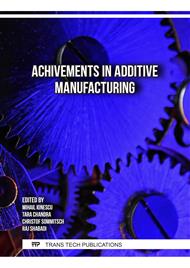p.1
p.7
p.13
p.19
p.27
p.33
p.41
p.47
Fatigue Life and Impact Toughness of PBF-LB Manufactured Ti6Al4V and the Effect of Heat Treatment
Abstract:
While additive manufacturing of metals has been rapidly growing industry for the past decade, the quality and the fatigue properties of the materials are still not very well known. In this study, we focus on the laser powder bed fusion (PBF-LB) manufactured Ti6Al4V. The as built material was compared to the heat treated counterpart by microstructural analysis, and the mechanical properties, impact toughness and the fatigue strength were determined. Bending fatigue testing was conducted for both as built and polished material to reveal the effect of surface roughness. The results showed that the heat treatment and the resulting microstructural change is crucial for the material properties and the material showed very brittle behaviour without it. According to the results, the surface quality plays also an important role in the fatigue life of the material, especially if no heat treatment is used.
Info:
Periodical:
Pages:
19-25
Citation:
Online since:
November 2023
Authors:
Keywords:
Price:
Сopyright:
© 2023 Trans Tech Publications Ltd. All Rights Reserved
Share:
Citation:



